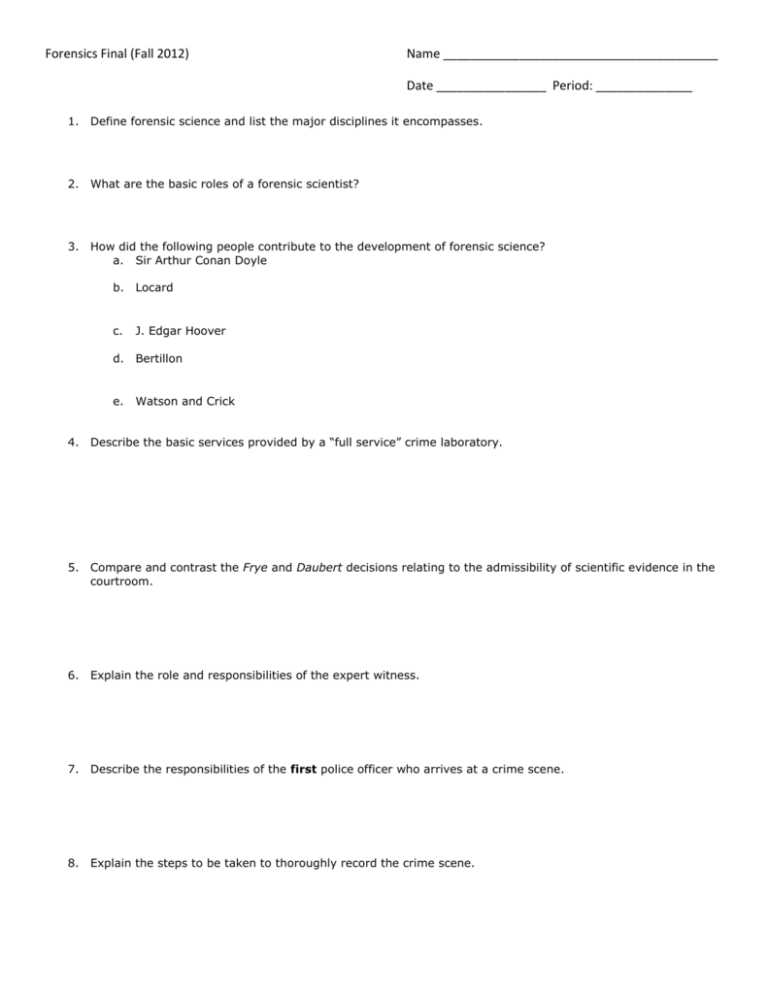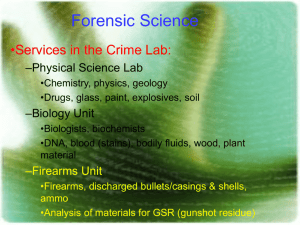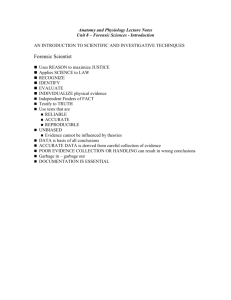Forensics Final (Fall 2012) Name Date Period: Define forensic
advertisement

Forensics Final (Fall 2012) Name ________________________________________ Date ________________ Period: ______________ 1. Define forensic science and list the major disciplines it encompasses. 2. What are the basic roles of a forensic scientist? 3. How did the following people contribute to the development of forensic science? a. Sir Arthur Conan Doyle b. Locard c. J. Edgar Hoover d. Bertillon e. Watson and Crick 4. Describe the basic services provided by a “full service” crime laboratory. 5. Compare and contrast the Frye and Daubert decisions relating to the admissibility of scientific evidence in the courtroom. 6. Explain the role and responsibilities of the expert witness. 7. Describe the responsibilities of the first police officer who arrives at a crime scene. 8. Explain the steps to be taken to thoroughly record the crime scene. 9. Describe proper procedures for conducting a systematic search of a crime scene for physical evidence. 10. Describe proper techniques for packaging common types of physical evidence such as blood, body fluids, hair and fibers, powders, and burned or charred evidence. 11. Describe the concept of “chain of custody”, and explain the importance of properly maintaining it. 12. Describe the roles the following scientists play in forensic science: a. Forensic entomologist: b. Forensic anthropologist: c. Forensic pathologist: d. Forensic odontologist: e. Coroner 13. Define the following: a. Circumstantial Evidence: b. Direct Evidence: c. Testimonial Evidence: d. Physical Evidence: e. Class characteristics: f. Individualized characteristics: g. Motive: h. Alibi: i. Means j. Opportunity 14. Decribe the following: a. Rigor mortis b. Algor mortis c. Livor mortis d. Fresh stage of decay e. Bloat stage of decay f. Active decay g. Advanced decay h. Dry stage of decay i. Adipocere j. Autolysis k. Putrefaction 15. What are the five categories that describe the manner of death? 16. List at least four factors that can affect the rate of decay of a human body. 17. Define and describe the function of the following: a. Erythrocyte b. Leukocyte c. Thrombocyte d. Plasma 18. List the A-B-O antigens and antibodies found in the blood for each of the four blood types: A, B, AB, and O. Blood Type A B AB Antigens Antibodies O 19. Define the following: a. Antigen b. Antibody c. Antiserum d. Agglutination e. Rh factor 20. Describe how a blood typing test is conducted, and explain and/or illustrate how to interpret the results. 21. List and describe three presumptive tests used to characterize a stain as blood. 22. How can the life cycles of insects as well as insect succession be applied to forensic investigations? 23. Illustrate and label the life cycle of the fly. 24. List at least three factors that can affect the rate of insect development. 25. What is the purpose of “The Body Farm”, and how has it advanced both forensic entomology and forensic anthropology? 26. Describe three clues the pelvis provides when trying to determine gender of skeletal remains. Be specific as to how these features help determine whether this is the skull of a male or of a female. 27. Describe three features of the human skull that provide clues to the gender of skeletal remains. Be specific as to how these features help determine whether this is the skull of a male or of a female. 28. Describe three features of the human skull that provide clues to the race of skeletal remains. Be specific as to how these features help determine whether this is the skull of a male or of a female. 29. Which bones of the body can provide the best estimate of height or stature? 30. Given an illustration of a human skeleton, be able to identify the major bones of the body as well as the major bones of the skull. 31. Compare and contrast nuclear DNA and mitochondrial DNA. 32. Define the following: a. Chromosomes: b. CODIS: c. RFLP: d. PCR: e. STR: f. Electrophoresis: g. Restriction enzyme: 33. Describe the basic structure of a DNA molecule including the matching base pairs. 34. Explain the technology of polymerase chain reaction (PCR) and how it applies to forensic DNA typing. 35. What are the advantages of short tandem repeats (STRs) over previous DNA-typing technologies? 36. List the necessary procedures for the proper preservation of bloodstained evidence for laboratory DNA analysis.







